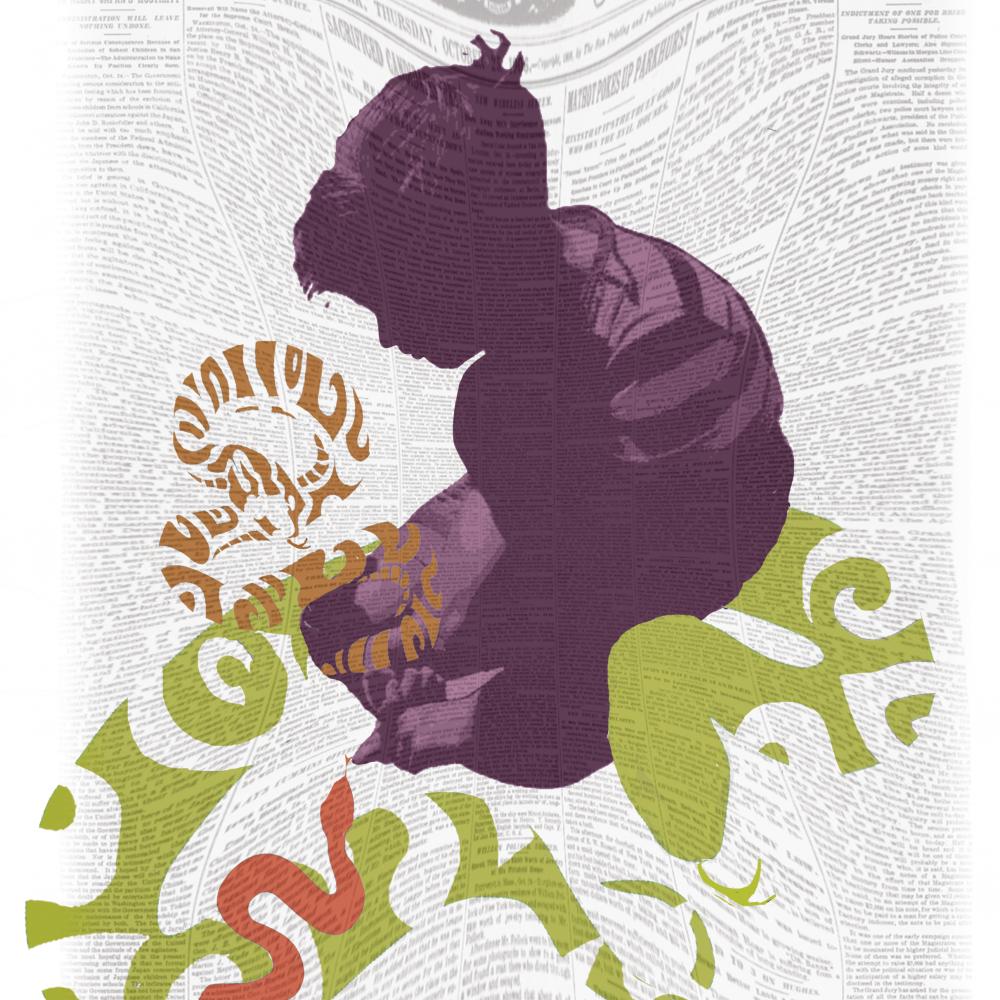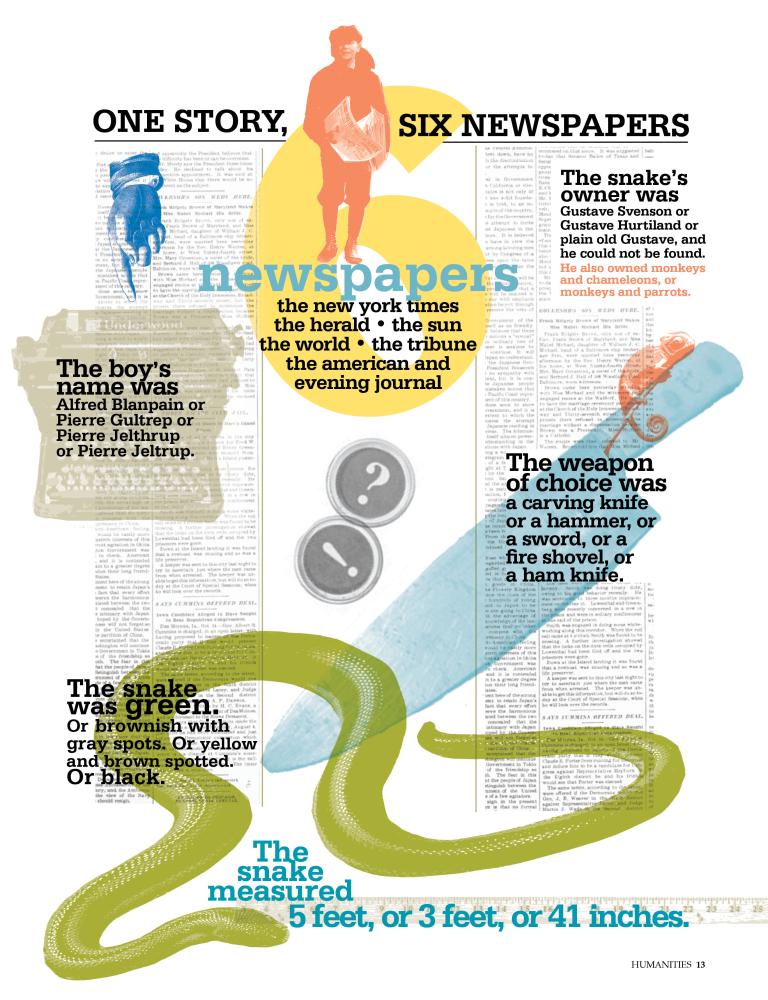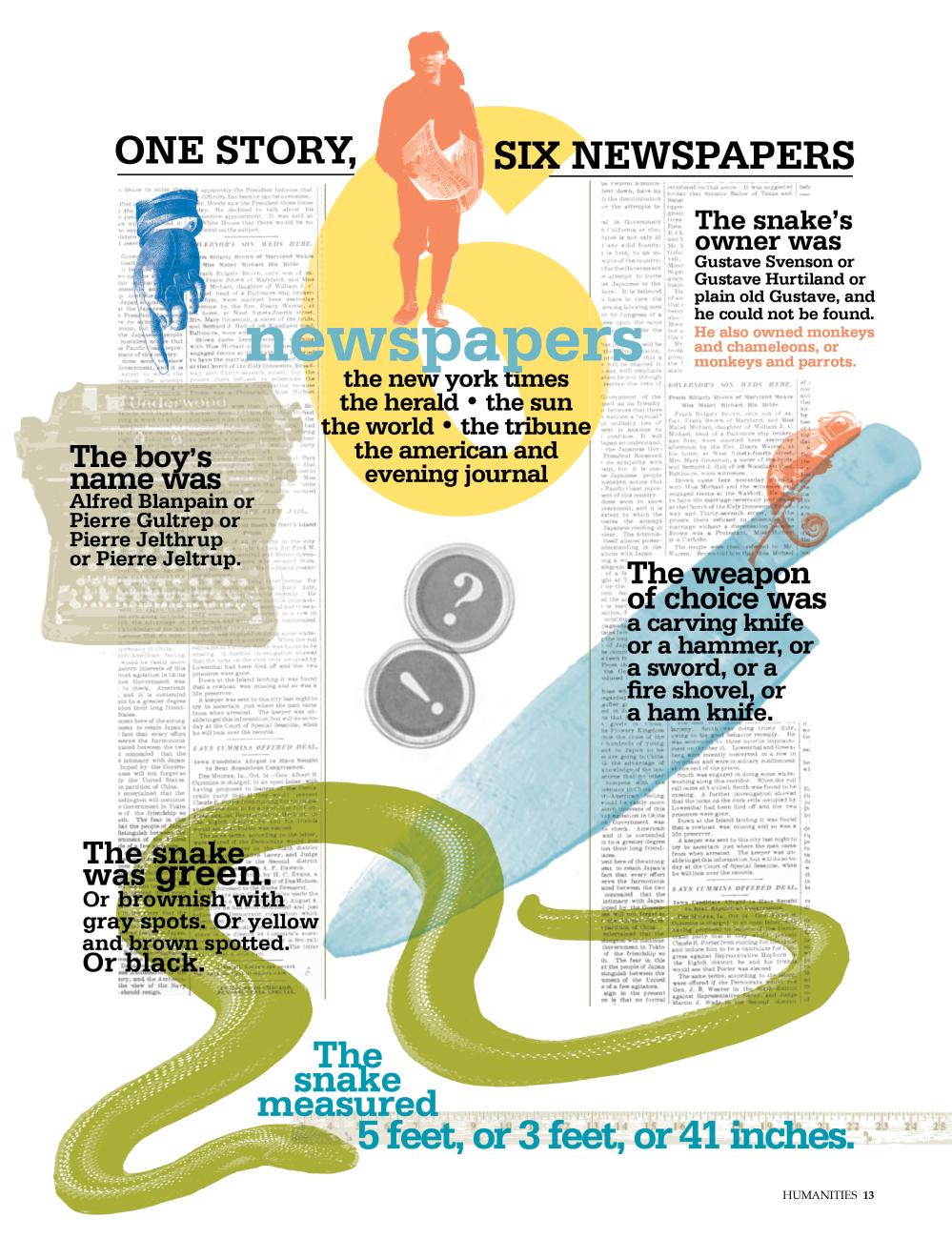Big events all over the world were keeping New York City’s newspapers busy on that last weekend in June 1904. From halfway around the globe came reports about skirmishes, ambushes, and sunken destroyers in the surprisingly fierce conflict between Japan and Russia. From Morocco came the news that a Greek-American businessman kidnapped by Berber brigands had just been released unharmed after tense, monthlong negotiations carried out in the shadow of a U.S. Navy squadron anchored menacingly off Tangier.
At home, federal authorities had announced a criminal investigation into the catastrophic wreck the week before of the excursion steamer General Slocum, which had caught fire during a day cruise up the East River and burned so quickly that more than a thousand of the 1,342 passengers and crew members died in the water or the flames.
And then there was that unforgettable story about the small boy and the snake in the family parlor.
For anyone interested in the past, old newspapers are a delight, offering glimpses into the nuts and bolts of daily lives long past and connecting us intimately to the things that communities once saw as important and interesting. They reveal not just what people used to talk about, but also how they talked about the things that mattered to them—how they shaped stories to make sense of their world.
And for anyone who delights in old newspapers, the digital revolution and the proliferation of searchable, full-text databases like Chronicling America, a partnership of NEH and the Library of Congress, have brought a world’s worth of treasures right to our computers and tablets.
Some of what we find in our searches is cozily familiar, a sign that even the newest technologies don’t change the most basic role of journalism as a society’s way of deliberating about what is true and real. Some of what we find is surprising, a reminder that ideas about what is true and real are neither eternal nor universal. And some of what we find seems, well, not entirely true and more than a little unreal.
In 1904 in New York, the nation’s biggest and most diverse city, dozens of daily and weekly publications were jostling for the attention of readers, who could choose papers for business people, for working people, for women, for African Americans, for reformers, for anarchists. They could choose papers in German, Yiddish, Italian, even Arabic and Croatian.
They could choose the old reliables like the Herald, once so shocking for its sauciness, and the Tribune, once so daring in its reformist zeal, both now decidedly overshadowed by the mass-circulation “yellow” papers like Joseph Pulitzer’s New York World and William Randolph Hearst’s American and Evening Journal, with their flamboyant stories, juicy headlines, gaudy illustrations, and fat Sunday editions full of comics, sports, and entertainment.
Or they could choose yet another revolutionary newspaper: the New York Times, which under the ownership of Adolph Ochs was emerging as a champion of a new approach to journalism. The Times embraced the idea that newspapers should be serious and respectable and public-spirited, that reporting should emphasize facts and should be carried out according to so-called scientific standards of objectivity and impartiality. Its motto, “All the News That’s Fit to Print,” carried the clear suggestion that some news—just wasn’t.
And on Sunday, June 26, a remarkable number of those newspapers found room for the saga of the little boy and the unwelcome reptilian guest. In the parlor of a modest apartment at 22 East 33rd Street, just outside the boundaries of the city’s notoriously louche Tenderloin district, family members observed a child playing contentedly with a shiny object that on closer examination turned out to be a live snake.
Frantic adults seized the nearest sharp object and swiftly dispatched the creature, which had probably escaped from a “menagerie” owned by the janitor who lived next door. The shaken family carried the corpse to the nearest precinct house.
That was it. That was the story. In fact, that bare outline is the only part of the story that everyone agreed on. In more than half a dozen different papers, in articles ranging from a two-inch squib to nearly a column in length, the story splintered into a multitude of differing details. The child’s name was Pierre Jeltrup. Or Pierre Jelthrup. Or Pierre Gultrep. Or . . . Alfred Blanpain. He was three years old, four years old, five years old, or a baby.
The snake measured three feet long, or five, or precisely “forty-one inches,” and its skin was green with yellow spots, or brownish with gray spots, or yellow and brown spotted. Or black.
The snake was executed by the child’s father. Or his grandfather. Or his uncle. Or his nurse—whose name was either Madeleine or Marie. The weapon of choice was a ham knife, a carving knife, a fire shovel, a hammer, or a sword. The rescuer chopped the snake “into mincemeat,” or into two halves that wriggled off in different directions.
When the carcass was borne off to the nearest police station, the unflappable desk sergeant identified it as a milk snake. Or he calmly pointed out that anyone has the right to select his own pet. Or he “unconcernedly” told the delegation to “take that damned thing out of here.”
The owner of the snake was Gustave Hurtiland, or Gustave Svenson, or plain old Gustave. He also owned monkeys and chameleons, or monkeys and parrots, or monkeys and squirrels and a Mexican dog, and he could not be found. Or he was found and interviewed at home, where he denied that any of his four snakes had gone missing.
While this cascade of variations may not give a reader much faith in the accuracy of the working press of 1904, it does something useful for an observer a century later. It offers a perfect primer on how various kinds of newspapers went about covering an entertaining local story in the era when standards of “professional” journalism were beginning to take clear shape.
Since, for instance, even the shortest versions of the story took pains to note that the family carried the dead snake to the West Thirtieth Street police precinct house in the Tenderloin district, and since most of them also carefully included the name of the desk sergeant there, we can presume that the news had been picked up in the precinct house by the police-beat reporters whom any respectable metropolitan paper maintained there round-the-clock and who doubtless enjoyed a mutually beneficial relationship with the unflappable Sergeant Shibles.
Some of the reporters saw nothing much in the story; the Herald man, for instance, was either as lazy or as preoccupied as his own slumping paper. He was the only one who got the boy’s name completely wrong—census records confirm that Alfred Blanpain was the grandfather of little Pierre Jeltrup—and he entirely missed the details about the janitor and his menagerie.
We can envision the Herald man commandeering the only chair in the reporters’ area inside the dilapidated old Tenderloin station, its big room illuminated by the sickly green lights that made the whole place feel like the morgue.
We can see him surrounded by the bustle of what the New York Times called “the most important police precinct in America . . . where tragedy and comedy walk together,” carelessly scribbling down half-legible notes about this little comedy while keeping an eye open for something a bit more interestingly tragic, in the process missing big chunks of what Sergeant Shibles had to say.
We might even imagine the reporter apologizing later to that very important man after the Herald copy desk mangled his name as Scheibles. And we can certainly picture his mortification the next day when he saw what some of his rivals had done with the same material—his only comfort being that the story by his paper’s oldest and fiercest rival, the Tribune, was even more perfunctory.
The Sun man, on the other hand, was inspired. Like the Herald, the Sun had long since outgrown its days as a brash upstart rag. It had remade itself into the city’s most literary paper, known for such elegant efforts as “Yes, Virginia, there is a Santa Claus,” the now immortal 1897 editorial response to an eight-year-old’s question.
Unlike the Herald reporter, the man from the Sun bestirred himself to walk the five or six blocks from the precinct house to the Jeltrups’ to see things for himself. And from the little contretemps over the snake he wove an elaborate story that unfolded in approved literary fashion, complete with picturesque details of the scene, vividly sketched characters—adorable boy, hysterical nurse, capable grandfather—and dramatic dialog, even including a bang-up quote from the little boy himself: “Marie, I got a nice big worm.”
Then the Sun man went next door and snagged a long interview with the Swiss janitor, Gustave Hurtiland, who appeared wounded by the implication that his creatures had caused the fuss. To prove how harmless his pets were, the janitor let his four green snakes crawl over his hands as the reporter watched. “None,” concluded the enterprising newshound as he brought his narrative arc to a tidy close, “was more than a foot in length.”
A reader could certainly be forgiven for harboring suspicions about whether every one of these literarily resonant elements was entirely real and true. But one detail does vouch for the Sun man’s credibility: He was the only reporter who came even close to the actual surname of the janitor, who is “Holderlin” in the 1900 census. Those who dubbed the janitor “Svenson” probably thought it was as good a name as any for someone who spoke a guttural language that wasn’t English.
One other version of the snake story stood out from the gray mass of newsprint that June day: the one by the sober, serious, respectable, public-spirited Times. But this time the distinction came not from its sobriety but from its hilarity.
Under a four-decker headline that begins “Gustave, He Have the Menagerie Hor-rible. Three-Foot Snake, He Visit Enfant Jeltrup Next Door. M. Jeltrup, He Slay Reptile,” the Times man wrote much of the account in a fractured franglais that sounds almost like a vaudeville routine.
“This is the city ter-r-rible, Monsieur Gendarme,” the paper quoted M. Jeltrup as telling the police sergeant. “I rent ze house, and I sudden find that my neighbor in hees house a terrible jungle possess. . . . He have snake—oh, miles of snake!”
“That’ll do,” responded the unflappable Sergeant Shibles. “We’ll investigate.”
The sober, responsible Times man investigated too, conducting a long interview with a different neighbor from next door, a Mrs. A. Palmer, who knew the zoophilic janitor well. Gustave, she explained, had no friends or family, and in his loneliness had collected a menagerie of live animals. She liked the monkey, said Mrs. Palmer, which was very playful, and she once saw a chameleon of a “lovely heliotrope tint” sliding down the balustrade.
Perhaps it’s not surprising that even the dignified Times could find giggly pleasure in a frivolous story, especially in the traditionally lighter Sunday edition. Certainly readers must have felt some relief in turning to the adventure of the baby and the menagerie after plowing through the grim tidings of threats abroad and fiery death at home.
But it’s also true that even a newspaper dedicated to providing all the news that’s fit to print understands that “fitness” can be defined in a way that allows it to let down its hair and compete for readers the old-fashioned way.
In the century since little Pierre Jeltrup’s encounter with the serpent, the Sun, the Herald, the Tribune, the World, the American, the Evening Journal, and almost every other New York daily alive in 1904 have fallen victim to the various and myriad perils that stalk the newspaper business—but some things never change. In 2009, a century after the snake story made its rounds, the New York Post and its fiercest rival, the Daily News, both ran long reports about the discovery by two seven-year-old Brooklyn boys of a boa constrictor hiding in the couch during a birthday gathering for one of them.
“Boy, oh, Boa! Boys Find Snake Hiding in the Couch,” cracked the News. “B’day Boy’s Hiss-Steria,” chortled the Post.
And they gave completely different names for the birthday boy who found the creature.




